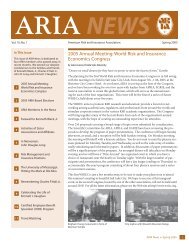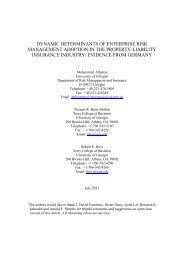EX-POST BEHAVIOR IN INSURANCE MARKETS* Greg Nini ...
EX-POST BEHAVIOR IN INSURANCE MARKETS* Greg Nini ...
EX-POST BEHAVIOR IN INSURANCE MARKETS* Greg Nini ...
Create successful ePaper yourself
Turn your PDF publications into a flip-book with our unique Google optimized e-Paper software.
has a claim of a particular size. The results suggest that policies with Rating Protection are<br />
more likely to have small claims (under A$1,000) but no less likely to have large claims<br />
(greater than A$5,000). Moreover, non-parametric estimates of the conditional severity<br />
distributions confirm the intuition that the differences in average claim amounts is driven by<br />
more mass in the left tail of the distribution for policies with Rating Protection. Simply, the<br />
data indicate that policies without Rating Protection seem to have fewer small claims than<br />
comparable policies with Rating Protection.<br />
Furthermore, the distributional differences are strongest for claims classified as at-fault<br />
by the insurance company. Conditional on a claim occurring, policies with Rating<br />
Protection are much more likely to have an at-fault claim, and the severity differences are<br />
not evident for no fault claims. Combined, the evidence suggests that the observed<br />
differences in outcomes are due to significantly more under-reporting by policies without<br />
Rating Protection.<br />
In order to explore the implication of under-reporting further, an econometric model of<br />
accident frequency and claiming behavior is specified. The observed claim distribution is<br />
assumed to be a censored version of the unobservable accident distribution, where the<br />
censoring happens stochastically (as in Nelson, 1977). Insureds are assumed to have an<br />
unobservable, stochastic threshold below which accidents will not be reported.<br />
Consequently, the insurance company only receives claims that are larger than this<br />
threshold. The observed mean claim severity is larger than the underlying mean accident<br />
severity, and the observed mean claim frequency is less than the underlying mean accident<br />
frequency. The unobserved threshold is permitted to vary with the status of Rating<br />
Protection, allowing identification of the effect that Rating Protection has on accident<br />
frequency, accident severity, and the claiming threshold.<br />
The econometric results suggest that the large increase in claim frequency is driven by<br />
policies with Rating Protection having a much lower claiming threshold and slightly larger<br />
accident frequency. Policies without Rating Protection engage in significant under-<br />
3






